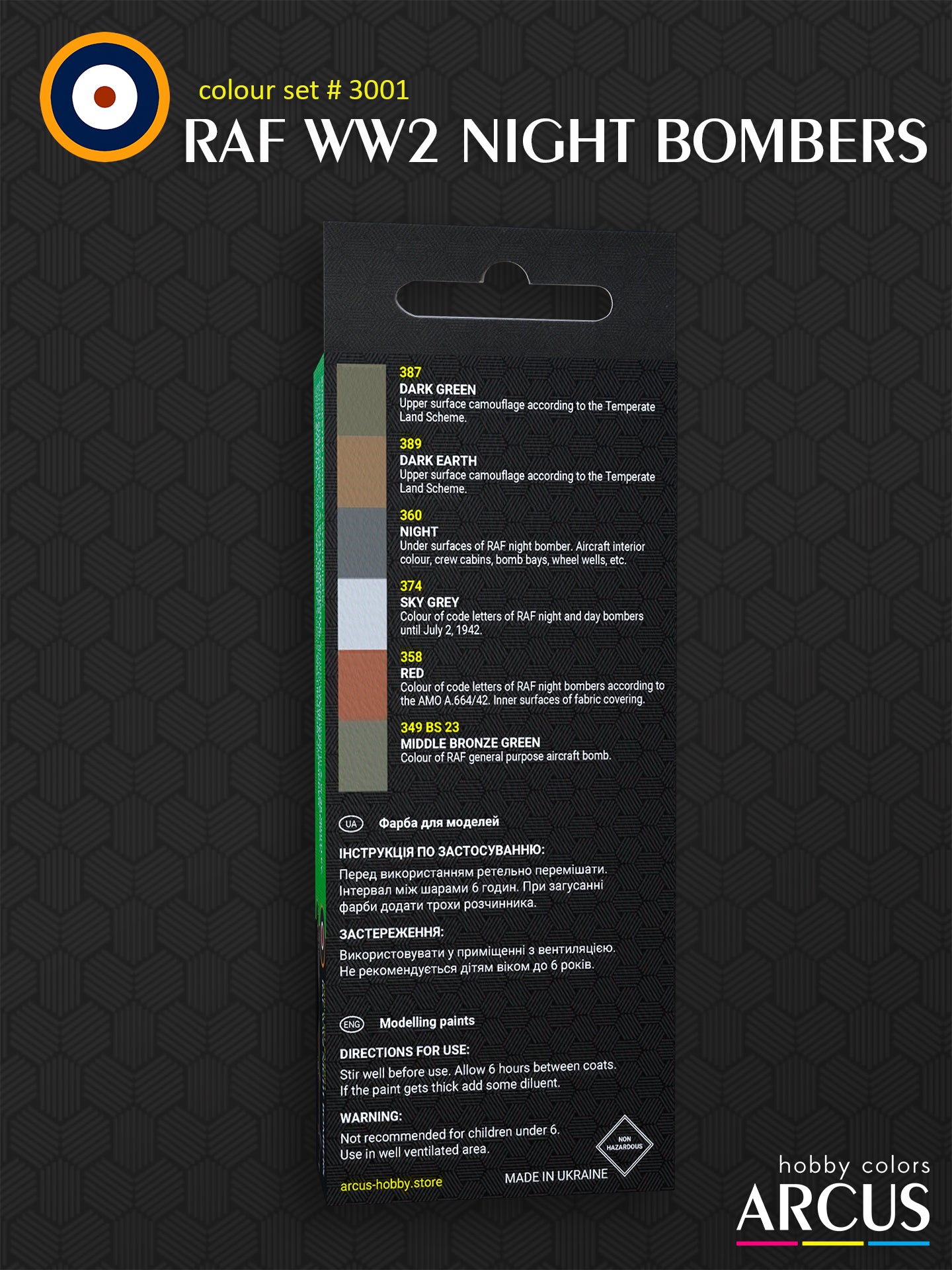Arcus Hobby
Paint Set 3001 RAF WW2 Night Bombers
Couldn't load pickup availability
RAF WW2 Night Bombers
During World War II, the Royal Air Force employed a diverse fleet of aircraft for night bombing operations, each contributing to the overall success of strategic bombing campaigns against Nazi-occupied Europe.
The Avro Lancaster, a four-engine heavy bomber, emerged as a symbol of the RAF's nighttime bombing capabilities. Renowned for its ability to carry substantial bomb loads and navigate through the darkness with precision, the Lancaster became a stalwart in the RAF's strategic bombing efforts.
Accompanying the Lancaster was the Handley Page Halifax, another robust night bomber that added to the RAF's formidable aerial arsenal. Together, these aircraft formed the backbone of the RAF's strategic bombing force, facing the challenges of navigating enemy territory in the dark while contending with the persistent threat of German night fighters.
In addition to the Lancaster and Halifax, the Short Stirling and Vickers Wellington played crucial roles in night bombing operations. The Short Stirling, with its distinctive high-mounted wings, contributed significantly to early RAF bombing campaigns. Meanwhile, the Vickers Wellington, a twin-engine medium bomber, proved its versatility in various roles, including night bombing missions.
As these RAF night bombers ventured into the hostile skies over Nazi-occupied Europe, they encountered formidable adversaries in the form of German night fighters, such as the Messerschmitt Bf 110 and the Junkers Ju 88. The Luftwaffe's night fighters, manned by skilled pilots, posed a constant threat to the RAF bomber crews, underscoring the dangers inherent in each mission.
One of the notable operations involving these night bombers was the "Battle of the Ruhr," a protracted campaign aimed at disrupting Germany's industrial heartland. Cities like Essen and Duisburg were targeted, and the Lancaster, Halifax, Stirling, and Wellington played pivotal roles in delivering devastating blows to key industrial centers.
The "Thousand Bomber Raid" on Cologne in May 1942 showcased the RAF's ability to coordinate massive night bombing missions, with Lancaster, Halifax, Stirling, and Wellington bombers overwhelming German defenses and inflicting significant damage on the targeted city.
Throughout the "Battle of Berlin," a sustained effort to cripple the German capital, all these bombers were instrumental in targeting infrastructure and breaking the morale of Berlin's citizens. Despite the relentless defenses of the Luftwaffe, the RAF night bomber crews pressed on through the perilous night skies, showcasing remarkable bravery and resilience.
The collective efforts of RAF night bomber aircraft, along with their gallant crews, played a vital role in shaping the course of World War II. Their strategic bombing operations significantly weakened the German war machine and contributed significantly to the eventual Allied victory in Europe.
Use Guide for the Set RAF WW2 Night Bombers
- During World War II, English night bombers typically featured camouflage according to the Temperate Land Scheme. This camouflage was introduced in 1938 and involved painting the upper surfaces of the aircraft in Dark Earth and Dark Green. The lower surfaces were painted in the Night color.
- In the early years of the Second World War, night bombers had gray lettering on the fuselage. In 1942, like other night aviation units, they adopted markings in the Red color.
- To enhance camouflage, the cockpits of night bombers' pilots and crews were also usually painted in the Night color. The remaining internal surfaces had the standard aviation Grey Green paint.
- Despite the introduction of the new color BS 23 Mid Bronze Green for bombs at the beginning of World War II, older mustard-yellow colored munitions continued to be actively used.
Set RAF WW2 Night Bombers Includes:
- 387 Dark Green - A dark green camouflage color of the upper surfaces.
- 389 Dark Earth - An olive-brown camouflage color of the upper surfaces.
- 360 Night - A bluish-black color of the under surfaces. It was also used for the aircraft interiors visible through the canopy glazing.
- 374 Sky Grey - An early-war basic gray color of the sqadron codes.
- 358 Red - A late-WW2 dull red color of the squadron codes.
- 349 BS 23 Middle Bronze Green - A dark green color of RAF general purpose aircraft bombs.
Collection:
This Set is Best for:
- Armstrong Whitworth A.W.42 Albemarle
- Armstrong Whitworth A.W.38 Whitley
- Avro Lancaster
- Avro 679 Manchester
- Bristol Blenheim
- Bristol Bombay
- Fairey Battle
- Handley Page HP.52 Hampden
- Short Stirling
- Vickers Wellesley
- Vickers Wellington, etc.
Paint Type:
- Acrylic A3001
- Enamel E3001
Paint Finish:
- Semi-gloss
Capacity:
- 6 x 10 ml. (6 x 0.33oz)





